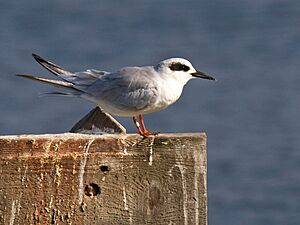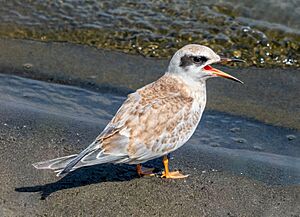Forster's tern facts for kids
Quick facts for kids Forster's tern |
|
|---|---|
 |
|
| Nonbreeding plumage in California | |
| Conservation status | |
| Scientific classification | |
| Genus: |
Sterna
|
| Species: |
forsteri
|
 |
|
| Breeding Migration Year-round Nonbreeding | |
The Forster's tern (Sterna forsteri) is a type of tern bird. It belongs to the family called Laridae, which also includes gulls. The name Sterna comes from an old English word for "tern." The second part, forsteri, honors a naturalist named Johann Reinhold Forster.
These birds breed in North America, often far from the coast. When winter comes, they fly south. They travel to places like the Caribbean and northern Central America.
Sometimes, a Forster's tern might fly off course. They are rarely seen in western Europe. It's unusual for a tern from North America to winter so far north in Europe.
Forster's terns live in large groups called colonies. They build their nests in marshy areas. They make a simple nest on the ground and lay two or more eggs. Like other white terns, they are very protective of their nests and young birds.
They catch fish by diving headfirst into the water. They also hunt insects in the marshes where they breed. In winter, they usually feed in salty water. Males often offer fish to females as part of their courtship.
Contents
Meet the Forster's Tern
The Forster's tern is a medium-sized bird. It is about 33 to 36 centimeters (13 to 14 inches) long. Its wings can spread 64 to 70 centimeters (25 to 28 inches) wide. It usually weighs between 130 and 190 grams (4.6 to 6.7 ounces).
This bird looks a lot like the common tern. Forster's terns have light grey feathers on their backs and wings. Their undersides are white. Their legs are red, and their bills are red with a black tip.
In winter, their forehead turns white. They have a special black mask around their eyes. Young Forster's terns look similar to adults in winter. Their call sounds like a harsh noise, similar to a black-headed gull.
It's easy to tell them apart from common terns in winter because of the eye mask. But when they are breeding, they look very similar. Forster's terns have a grey center on their white tail. Their upper wings are pure white. Common terns have a darker wedge on their primary wing feathers.
What They Look Like: Different Plumages
When not breeding, the Forster's tern has a white head. A black, comma-shaped patch covers its eye and ear. Its wings are grey, and its belly is white. The bill is black, and the legs are a dull brownish-red.
When it's time to breed, the bird gets a bright black cap. This cap extends down its neck. Its wings and back become pale grey. The underside is bright white. It has an orange bill with a black tip and bright orange legs.
Young terns have colors similar to non-breeding adults. But their primary wing feathers are often darker.
Where Forster's Terns Live
Forster's terns are marsh birds. They can live in fresh, salty, or slightly salty water. You often find them over shallow, open water deep inside marshes. Their main homes include marshes, river mouths, islands, and marshy areas around lakes and streams.
These birds mostly live in North America. They nest in marshes during the summer. This can be on the Atlantic or Pacific coasts. They also nest in the Prairies or near the Great Lakes in Canada and the US. Their nesting spots can change a lot each year.
Forster's terns also spend their winters in marshes. These are found along the southern coasts of the US and Mexico. Sometimes, they even go as far south as northern Central America. It's also common for them to winter in the Caribbean.
Occasionally, a Forster's tern will fly to Western Europe. They have sometimes spent the winter in Great Britain and Ireland.
Forster's Tern Behavior
Forster's terns are often seen in marshes over shallow water. They are plunge-divers, meaning they dive into the water to catch food. They often hover in the air before diving. When hunting, their head points down. When just flying, their head points forward.
They nest in groups called colonies. They build simple nests using marsh plants. They sometimes compete with gulls for nesting spots. A colony can have anywhere from a few pairs to a thousand birds. Forster's terns often share nesting sites with Yellow-headed blackbirds.
Both parents help care for the young. Males tend to guard the nest more during the day. Females are more present at night. If disturbed, newborn chicks will crouch down and stay quiet. Parents bring food to the chicks, usually one prey item at a time. The size of the prey matches the size of the chick.
Before breeding, males perform a special courtship feeding ritual. They offer food to the female.
Vocalization: What They Sound Like
The common call of the Forster's tern is a descending "kerr." When they feel threatened and are defending their nest, they make a low, harsh "zaar" sound. Females use a series of "kerrs" as a begging call during courtship.
Diet and Feeding Habits
Fish make up most of the Forster's tern's diet. In freshwater, they eat fish like carp, minnow, sunfish, and trout. In salty or brackish water, they eat fish like pompano, herring, and menhaden. On the West Coast, they also eat young Pacific lampreys.
They also eat insects like dragonflies, caddisflies, and grasshoppers. Sometimes, they eat aquatic insect larvae, small crustaceans, and amphibians.
The Forster's tern is a shallow plunge-diver. Its head points down when it's hunting. The dive usually starts from a hovering position. They dive headfirst with their wings partly folded back. They might catch insects while flying. Sometimes, they drop and re-catch fish before swallowing them. In some areas, they prefer to hunt in cloudy water. This might help them hide, or it could mean more prey is near the surface.
Reproduction and Life Cycle
The breeding season for Forster's terns can start in April in the southern US. It can last from May to mid-June, depending on how far north they are. They nest in colonies that can have from one to a thousand nests. Adults claim a very small area around their nest. Nests are usually close together. Males will offer food to females as part of courtship. Females will beg for food with a "kerr kerr kerr" call.
A typical nest has 2 to 4 eggs. The eggs hatch after 24 or 25 days. The young are semi-precocial, meaning they are quite developed at birth. Parents remove the eggshells. Chicks have small egg teeth on their bills, which they lose after 3 to 5 days. Chicks usually leave the nest with their parents after 4 days. They move into areas with thicker plants. They learn to fly about 28 days after hatching. After a few weeks of flying, young terns leave their birth colony. But they join the group for sleeping spots as they fly to their winter homes.
Both male and female terns help with incubating eggs and raising chicks. Males tend to sit on the eggs more during the day. Females are mostly on the nest at night. How many chicks survive changes each year and from colony to colony.
Mobbing Behavior
Forster's terns are very aggressive when predators threaten their nests. If a nest is disturbed, the whole colony will mob the attacker. They dive towards it and make loud calls. Their aggressiveness increases just before and during the hatching of chicks. Ducks and grebes nesting nearby often benefit from the terns' aggressive behavior.
Yellow-headed blackbirds that share nesting sites have been seen joining the terns to mob predators. Western grebes can understand the tern's alarm call. This is like them getting free information about danger.
Forster's Tern Nests
Forster's terns usually nest in marshy areas. This can be in freshwater or where rivers meet the sea. Nests are often deep inside the marsh. They might be on islands that appear with the tides or on man-made dikes. Nests are built from nearby marsh plants. Many nests float and are made of marsh grasses. They can be placed on top of plants or on floating rafts of plants. In Manitoba, Canada, Forster's tern nests are often found near muskrat houses. These houses are popular nesting spots. In Manitoba, Scirpus and Typha plants are mainly used for building nests.
In very large colonies, there might not be enough nesting space. Then, Forster's terns will nest on sand, gravel, or mud. These nests are just a hollow in the ground. They might be lined with grass or not. They also use driftwood, shells, dried fish, bones, and feathers.
Floating nests can handle small changes in water level. But if there's strong waves, wind, or flooding from a storm, the nests and eggs can be damaged. Bad weather is the main reason nests fail and eggs are lost. Nests that are not protected are more likely to be destroyed. Nests built on higher ground are safer from floods but more exposed to wind.
Forster's Terns have been seen using man-made platforms. In Wisconsin, these platforms were built to replace natural nesting areas. The terns used them successfully. They preferred these platforms to avoid the dangers of natural nests.
Forster's Tern Eggs
The main color of the eggs can be greenish or brownish. They have dark brown, almost black, or grey spots spread evenly over them. The color can vary between and within a group of eggs. Earlier eggs are usually lighter, greener, and larger. Egg color can also depend on the location. Some eggs have been reported as whitish or cream-colored.
Predators of the Forster's Tern
Raptors like falcons and hawks, as well as owls and corvidae (like crows), may hunt adult terns and their young. There have also been stories of snapping turtles eating young terns still in the nest. American Bitterns, Great Blue Herons, and Black-crowned Night-herons are also possible predators. Gulls and Caspian terns are known to eat Forster's Tern eggs.
Where their homes overlap, marsh rice rats are possibly the best at finding and eating Forster's Tern eggs. Minks are also one of the few mammal predators that can go into the marsh. They prey on eggs and young terns.
Predator success usually stays low during breeding season. This is because the adult terns are very aggressive and mob their attackers.
Status and Conservation
The IUCN (International Union for Conservation of Nature) says the Forster's tern is of "least concern." This means it's not currently in great danger. However, the loss of marsh habitat could be a threat. Boating activity can also harm nest plants and cause erosion. This can further damage tern nesting areas. Too much noise might also cause birds to leave their nests. It can also lead to chicks dying.
This species is protected under the Migratory Birds Treaty Act in the U.S. It is listed as endangered in Illinois and Wisconsin. It is a species of special concern in Michigan and Minnesota. Protecting wetlands and building artificial nesting sites can help save the species in high-risk areas.
More carp in drainage systems can damage marsh plants. This might limit the available habitat for Forster's terns. There have also been stories of carp spawning very actively. This activity has damaged the terns' floating nests.
Like many fish-eating birds, Forster's terns can build up pollutants in their bodies. High levels of mercury can cause stress. This reduces the overall health of the terns. Mercury can become more harmful in marshes and salt ponds. This makes Forster's terns more vulnerable. High levels of Selenium can also harm their health. Organochlorine pollutants like PCB can also lower their breeding success.
Gallery
-
Forster's tern fishing on Lake Mattamuskeet







